https://www.pianonanny.com/page1.html
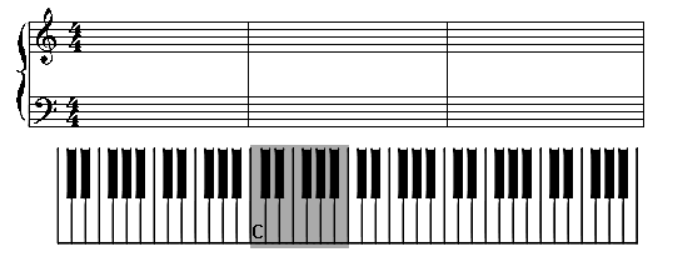
Starter Studies
Lesson 1 - Section 1
Welcome to PianoNanny.com
The images in this tutorial will be minimal so that the loading speed into your browser will be as fast as possible. On a desktop computer, the images display in the right-hand column. On mobile devices, the images display at the bottom of each lesson section. Please note that this course uses HTML 5 embedded mp3 audio files.
Also, you will need to have at least a small portable keyboard in front of you as you go through these lessons so that you can look at it and become familiar with it. Learning a keyboard is like typing. You need a typewriter keyboard in front of you to learn to type. The same is true of the piano. You need a piano keyboard in front of you to learn to play piano. A small Casio or Yamaha portable keyboard with built-in speakers would work just fine.
First Look at the Piano Keyboard
As you first look at the piano keyboard (see image), it looks like there are lots and lots of notes to learn. Not so! You only need to learn 12 notes. The shaded area on the keyboard in the image shows the 12 notes you will need to learn. Notes on a piano are grouped in sets of 12 notes.
Each group has 7 white keys and 5 black keys. Look at the keyboard above and count the 7 white keys and 5 black keys in the shaded area. This is one group. This group is repeated over and over, up the keyboard and down the keyboard. Each group starts with a “C” note. See the note labeled “C” above? On any keyboard, “C” is always the first white key that is to the left of two black keys.
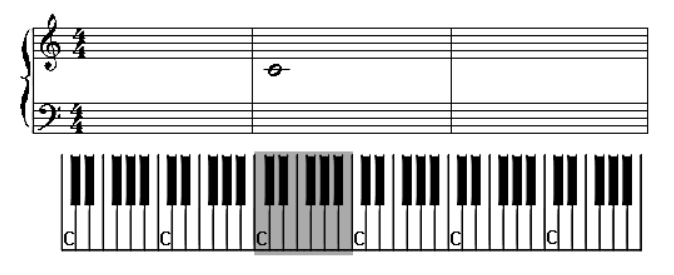
Lesson 1 - Section 2
More "C" Notes
Here are more “C” notes. See how they are all located next to two black notes? Good job. . . you have learned where “C” is on the piano. This is a big step because you will always need to locate “C” before you begin to play a song on the piano.
To make this even easier, you only need to locate one “C.” This special “C” is called middle C. It’s called middle C because, when you sit down at the piano to play, it is the “C” that is straight in front of you and in the middle of the keyboard. Look at the picture of the keyboard again. You will see some lines, symbols, and numbers. This is called a Staff. Middle C is also in the middle of the Staff.
The Staff is Where the Language of Music is Written
The Staff is where the language of music is written. Yes, music is a language just like any other (English, French, Spanish). It has rules and special characters and so forth. This language tells you what to play and where to play it on your instrument. There is only 1 note currently shown on the staff above (the circle with a line through it). This note is middle C. Let’s learn some more notes on the staff and how they relate to the piano keyboard.
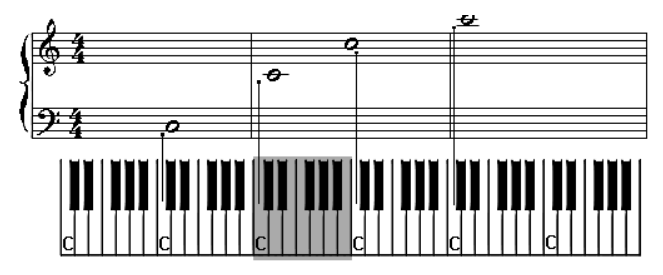
Lesson 1 - Section 3
How "C" Notes Look on the Staff
Here are some other “C” notes and how they look when they are written on the staff. See middle C in the shaded area? Go to the right and look at the next “C” above middle C. Now go to the left and look at the next “C” below middle C.
Count the keys on the keyboard (including the black keys) and you will find that there are 12 keys (notes) between each “C” on the keyboard. On the Staff, above the keyboard, count the lines and spaces between two “C” notes and you will find that there are a total of 8 lines and spaces between two “C” notes.
Learning About Octaves
This spacing of 12 half steps (includes white and black notes) on the keyboard or 8 (includes lines and spaces) on the staff, is called an Octave. In the image, you are looking at Octaves on the staff and on the keyboard, (from one “C” note to the next “C” note). You will eventually learn all the notes in 1 octave. The octave we will concentrate on will include middle C.
For now, go ahead and find all the “C” notes you can on your keyboard.
NOTE: Keyboards come in different widths so don’t worry if you end up with more or less “C” notes than the keyboard shown in the image. Look for two black keys and then the first white key to the left of these black keys. This white key will always be a “C” note.
Now that you’ve mastered “C” notes, it’s time to learn the other 11 notes in 1 octave.
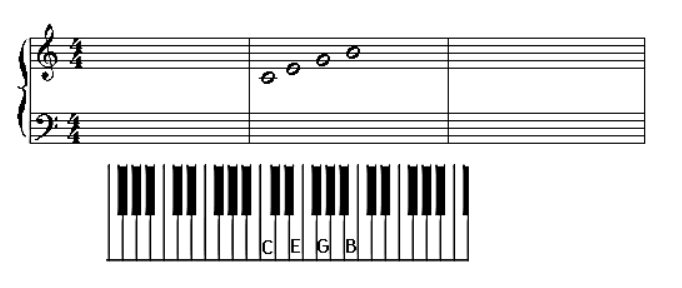
Lesson 1 - Section 4
Notes Written on Lines
Let’s start with the lines on the staff above. The notes that are written on the lines in the staff are “C,” “E,” “G” and “B“. You can make up a fun sentence to help remember the names of the notes that are written on the lines in the staff. Example: Cows Eat Glue Buckets. Make up one for yourself and write it down somewhere. Keep it close to your keyboard for reference.
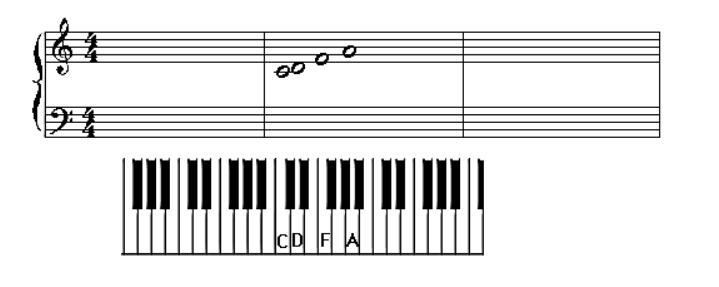
Lesson 1 - Section 5
Notes Written on Spaces
Now let’s look at the spaces on the staff. I’ll leave the “C” note in just for reference only. It is not on a space. The notes that are written on the spaces in the staff are “D,” “F” and “A“. You can make up a fun sentence to help remember the names of the notes that are written on the spaces in the staff. Example: Dogs Find Apples. Make up one for yourself and write it down somewhere. Keep it close to your keyboard for reference.
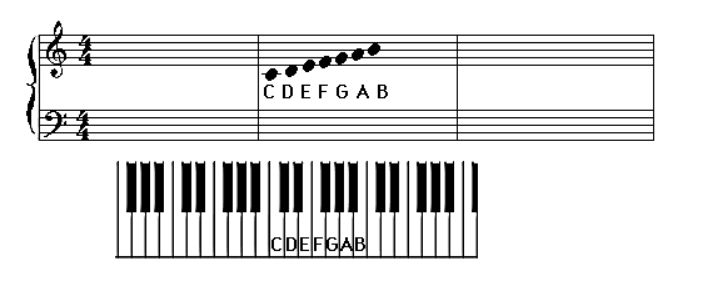
Lesson 1 - Section 6
Congratulations!
Give yourself a pat on the back and a final look at the notes you’ve learned today. You have now mastered the white notes on a keyboard. Next we will learn the black notes. Both white and black notes are important to learn if you are intent on learning to play the piano in more than one key. For now, look over this lesson and play these notes on your keyboard. Say each note in your head as you play it. Practice. No one learned anything without practice. Now how about taking a short quiz to test yourself?
Click or Tap to take Quiz


No comments:
Post a Comment